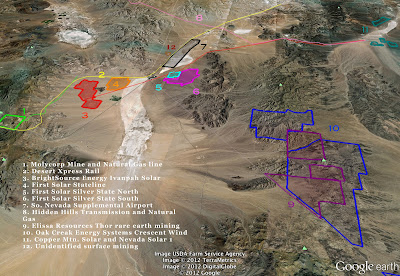BLM Takes Another Piecemeal Step in Ivanpah
last post), and an extension of a desert wildlife management area (DWMA). Both land use changes provide substantial carve-outs for the ill-sited solar projects, rendering the conservation steps meaningless toward their original intent of preserving a north-south genetic linkage for the desert tortoise, and preserving special status plant populations. The massive loss of habitat is sure to impact other species, removing foraging habitat for raptors and bighorn sheep active in the area.
The Google Earth image below (also available in a larger PDF at the bottom of this post) depicts the locations and footprints of some of the more substantial projects built, under construction or proposed for the Ivanpah Valley and vicinity.
 |
| Click on image to expand |
- The BLM's analysis does not account for a proposed transmission and natural gas line that would traverse desert habitat just north of Primm, Nevada and connect Brightsource Energy's Hidden Hills Solar project (over 30 miles away) to existing transmission and natural gas lines in the Ivanpah Valley and El Dorado Valley.
- The BLM does not evaluate plans by Elissa Resources to mine rare earth elements on the eastern edge of the Ivanpah Valley -- the company drilled 21 core samples this summer that revealed "significant" deposits. If the company begins larger scale mining operation, extensive surface disturbance, water usage, and natural gas and power facilities may be required.
- Partially overlapping with the Elissa Resources mining claims, Oak Creek Energy Systems plans to install over 220 wind turbines for the proposed Crescent Peak Wind project along the eastern edge of the Ivanpah Valley and adjacent to the South McCullough Wilderness.
A downloadable PDF version of the map included above.



These maps are conclusive, the Ivanpah Valley is about to be split in half, with dire consequences for the plant and animal life and for the local ecosystem.
ReplyDelete